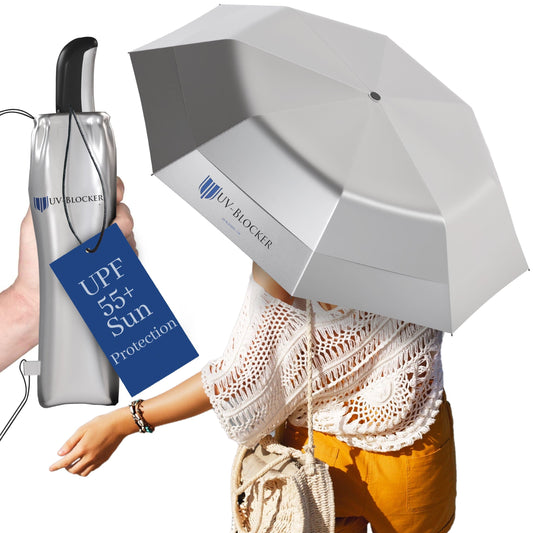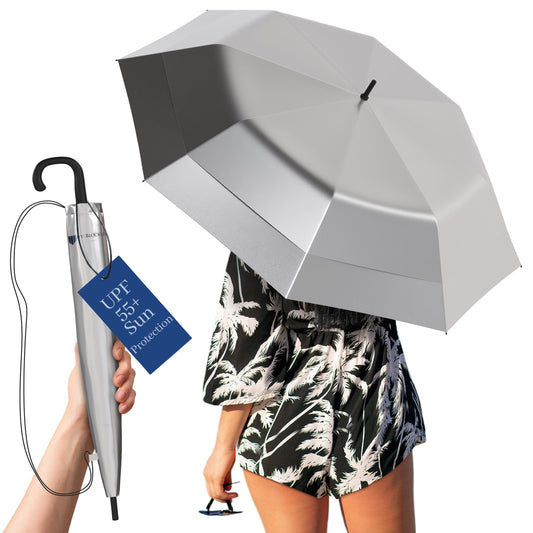Sun Protection in Autumn: Why You Still Need Sunscreen and a Sun Umbrella After Summer Ends
As summer fades and the crisp days of autumn roll in, many of us may be tempted to put away our sunscreen and UV protection gear. After all, the temperatures are dropping, and the sun doesn’t feel as intense as it did just a few weeks ago. However, sun protection remains essential even as the leaves change color and the air turns cooler. Ultraviolet (UV) rays from the sun are still potent in autumn, and without proper precautions, they can continue to damage your skin.
But beyond sunscreen, there's another tool to help you stay protected year-round: a sun umbrella.
The Hidden Danger of Autumn Sun
In the summer, it’s easy to remember to apply sunscreen—scorching temperatures, beach outings, and outdoor activities make sun exposure more obvious. But in autumn, we often overlook the need for sun protection. One key reason for this oversight is the change in how the sun's rays hit the Earth. As the sun moves lower in the sky and shifts more to the southwest during the fall months, we might think we're safer from harmful UV radiation. However, this positioning can actually lead to more sunlight streaming through office windows, car windshields, or even while walking to the store in the afternoon.
It’s important to note that UV rays, which cause skin damage and contribute to skin aging and cancer, are present all year round. Even on cool or cloudy autumn days, up to 90% of UV radiation can penetrate light cloud cover, making it critical to maintain your sun protection routine.
UVA vs. UVB Rays: Understanding the Risks
There are two main types of UV rays that affect your skin: UVA and UVB. While both are harmful, they work in different ways:
- UVA Rays: These rays have longer wavelengths and are primarily responsible for skin aging. They penetrate deeper into the skin, causing wrinkles, fine lines, and sagging. UVA rays are consistent throughout the year, regardless of temperature or season, and can even pass through glass. This means that during autumn, you may still be exposed to UVA radiation indoors if you spend time near windows or in a car.
- UVB Rays: These rays have shorter wavelengths and are primarily responsible for causing sunburn. UVB intensity varies throughout the year, peaking between 10 a.m. and 4 p.m. from April to October in the United States. However, UVB rays are still present in the fall and winter months, especially at higher altitudes or near reflective surfaces like snow or water.
While UVB rays fluctuate more with the seasons, UVA rays remain constant year-round. This makes it essential to use a broad-spectrum sunscreen that protects against both types of UV radiation no matter the time of year.
Sun Umbrellas: A Powerful Shield Against Harmful Rays
While sunscreen is an important part of sun protection, adding a Sun umbrella to your routine can provide an extra layer of defense against harmful rays. UV umbrellas are specially designed to block a significant percentage of both UVA and UVB rays, making them a great tool for year-round sun safety. Here are some of the key benefits of using a UV umbrella:
- Protection on the Go: A UV umbrella offers portable, instant protection wherever you go. Whether you're running errands, walking to work, or attending an outdoor event, a UV umbrella creates a physical barrier between you and the sun’s harmful rays.
- Blocks More Than Sunscreen Alone: Even the best sunscreens need reapplication every few hours, especially if you sweat or get wet. A UV umbrella provides continuous coverage without the need for constant touch-ups. It also shields parts of your body you might forget to cover with sunscreen, like your scalp or neck.
- Cooler and More Comfortable: Unlike sunscreen, which only protects your skin, a UV umbrella keeps you cool by providing shade. This can make a big difference during warm autumn days, reducing the amount of heat you feel while still protecting you from UV radiation.
- Great for Sensitive Skin: For those with sensitive skin, reapplying sunscreen frequently can sometimes cause irritation. A UV umbrella allows you to limit direct sun exposure without relying solely on topical solutions, making it a great option for people with allergies or skin conditions like eczema.
- Year-Round Use: Since UV umbrellas block UV rays, not just heat, they are effective even during cooler months when the sun doesn't feel as strong. They are also handy in areas with reflective surfaces like snow, which can amplify UV exposure in winter.
Autumn Sun and UV Radiation: What to Know
As autumn approaches, many of us look forward to pumpkin spice lattes, cozy cardigans, and cooler weather. But don’t let the golden leaves and cooler temperatures fool you—sun protection should still be a priority. Even though the autumn sun doesn’t feel as hot as the summer sun, it can still cause UV damage to your skin. The reduced intensity of sunlight can make us forget how dangerous UV rays are, leading to a false sense of security.
Additionally, where you live and the day’s weather can significantly affect the amount of UV radiation you are exposed to. UV levels are highest under clear skies, but even on partly cloudy days, enough UV rays penetrate to cause skin damage. Those who live in higher elevations or near reflective surfaces like snow or water need to be especially cautious. UVB rays can bounce off these surfaces and hit your skin, increasing your exposure. This means activities like skiing or hiking in the mountains still pose a risk for sun damage during the cooler months.
Simple Ways to Protect Your Skin This Fall
Staying sun-safe in autumn doesn’t require a drastic change in your routine. With a few simple steps, you can keep your skin protected from UV damage:
- Use broad-spectrum sunscreen daily: Look for a sunscreen with at least SPF 30 that protects against both UVA and UVB rays. Apply it to exposed areas, including your face, neck, and hands, even if you’re spending most of your day indoors.
- Reapply regularly: Just like in summer, it’s important to reapply sunscreen every two hours, especially if you’re spending time outdoors.
- Incorporate a UV umbrella: Add a UV umbrella to your daily routine for portable protection. It’s especially helpful during walks, outdoor events, or trips to the park.
- Cover up: Wear protective clothing, including wide-brimmed hats and sunglasses, to shield your skin from the sun’s rays. Don’t forget about your hands, which are often exposed and can show signs of aging from sun damage.
- Be mindful of your surroundings: Pay attention to reflective surfaces and windows that can increase your UV exposure, even when you’re not directly in the sun.
Conclusion: Year-Round Sun Protection with Sun Umbrellas
As we transition from the heat of summer to the cooler days of autumn, it’s easy to let sun protection slip from our minds. However, UV radiation doesn’t take a break when the seasons change, and the damage it causes to your skin is cumulative. Incorporating a UV umbrella into your sun protection routine, alongside regular use of broad-spectrum sunscreen, is an effective way to shield your skin from harmful rays year-round.
By staying vigilant and protecting your skin even as the temperatures drop, you can reduce the risk of sunburn, premature aging, and more serious issues like skin cancer. Remember, sun protection isn’t just for summer—it’s a year-round necessity!








